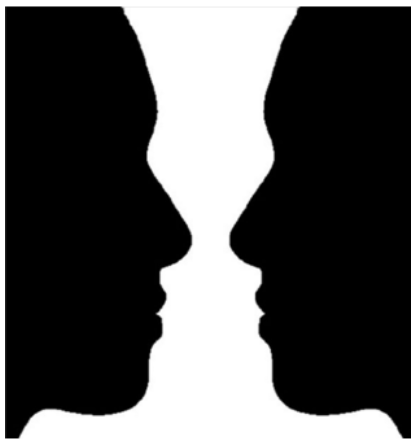
What is Family Therapy?
Many of us are familiar with this image of two faces with a vase that is visible between them, if you shift your focus. Family therapy (sometimes called “systemic” therapy) has a slightly different focus than therapies that tend to focus on individuals (i.e., the faces). In family therapy, the therapist’s job is to look closely at the space between family members as they interact with each other; specifically, patterns of interaction and communication that have stabilized in family members’ relationships with each other.
A common assumption among family therapists is that families have repertoires of patterns – some that will tend to bring forth wellbeing, and some that won’t. Families are likely to benefit from this kind of therapy if family members are often engaging in patterns in their day-to-day interactions that tend to negatively impact the participants’ mental health and wellbeing. If anything is going to be “diagnosed” in family therapy, it will be the family’s Interpersonal Patterns (or, “IPs”).
An underlying assumption of the model used to distinguish IPs is that behavior can be usefully viewed as an invitation. Viewed from this perspective, each person’s response can be depicted as contributing to the pattern in some way. The patterns that evolve between family members can seem to take on a life of their own and almost induce participation. Patterns that tend to bring forth both pathology, such as mental health problems in family members, and patterns that tend to bring forth healing or wellness can both be distinguished in this way. For example:
How Can Family Therapy Help?
The therapist’s role is to help shift the amount of time spent engaging in unhelpful patterns. In order to facilitate this shift, a family therapist will help clients to become more aware of what is happening in their day-to-day interactions and to develop the skills necessary to shift unhelpful patterns towards those that are more likely to promote health and wellness.
This model of therapy is particularly useful in instances where children or adolescents are manifesting emotional or behavioural challenges. Family therapy is useful because children are less powerful in the family system and also less capable of change owing to being at earlier stages of cognitive/emotional development than adult family members.
If therapists are able to help family members learn to de-escalate conflict and create the conditions for calm, open communication among family members, the effects on children and teens will often be positive. Another benefit is that children feel their voices are being heard, rather than feeling put in the “hot seat” and being asked to change their behaviour while the “injustices” they perceive elsewhere in their family remain unaddressed. Family therapy takes a balanced approach to working with an entire family system.
What is the success rate of family therapy?
According to the Cleveland Clinic, after participating in family therapy treatment,
- Almost 90% of people report an improvement in their emotional health.
- Nearly 66% report an improvement in their overall physical health.
- In child-parent cases, about 73% of parents report that their child’s behavior improved.
Family Therapists May:
Elicit each family member’s description of “the problem” bringing them to therapy
- Clarify differences in perspective
- Explore how family members typically attempt to resolve differences in perspective, and what effects those attempts are having on different family members
- Clarify discrepancies between intentions and effects (e.g., what did you mean to do/say? … how were your good intentions heard or interpreted by other family members?)
- Explore interpersonal perceptions (e.g., ‘what do you imagine your mom was thinking when she did that?’)
- Work towards developing shared understandings among family members about each other’s hopes, preferences, intentions, beliefs, values, needs, etc.
- Work towards developing consensus about what tends to help and what tends to hurt
- Focus more on process than content (e.g., how family members talk together in general vs. focusing on the elaborate details of specific conflicts)
- Help family members develop their awareness of how to communicate in ways that create the conditions for emotional safety
At Eckert Centre, individual therapy for all ages is available along with family therapy and couples counselling. Visit https://eckertpsychology.janeapp.com/ to book your New Client Initial Intake Session or a free consultation call with one of our team members.
Faye Gosnell is a Registered Psychologist at Eckert Psychology & Education Centre. Faye holds a BA in Psychology, a BA (honors) in Sociology as well as a Masters of Counseling. Faye’s primary Counselling approach is using Family Therapy in supporting families, couples and other relationships. Faye also integrates other therapies, such as Eye Movement Desensitization Reprocessing (EMDR) Therapy, to further give voice to what her clients may not be consciously aware of.
For additional information see:
- The Canadian Centre for Addiction and Mental Health’s description of family therapy.
- My Health Alberta’s overview of family therapy.





